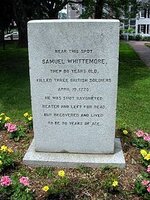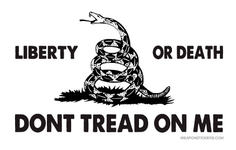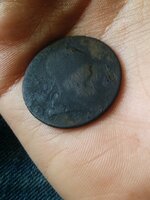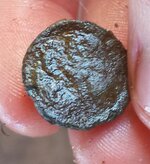Red James Cash
Banned
- Aug 20, 2009
- 12,824
- 7,899
- Detector(s) used
- Garret Master hunter Cx Plus
- Primary Interest:
- Other
Happy Patriots Day.
Today in history the American revolution began with the battle of Lexington and Concord.In honor heres a couple of true stories concerning the battle.
Death on a Pale horse.
Hezekiah Wyman
There was a middle-aged Militiaman that stood out on the battlefield on April 19th, 1775. His name was Hezekiah Wyman from the town of Woburn, now called Winchester, MA.
Hezekiah was 55 years old on April 19th and his wife assured him that he was too old to fight.
Undaunted, Hezekiah gathered up his musket, powder and ball and saddled his strong white mare to gallop toward his destiny.
When he encountered the British column on the road east of Lexington, he stood alone against hundreds of the King's finest troops. Rather than retreat to a safer position, he fired upon an advancing Redcoat, dropping him with a single shot.
Hezekiah became well known to both sides this day - a "tall gaunt man with long gray hair mounted on a beautiful white horse". He must have been a sight behold.
The British infantry grew to rue the sight of this solitary soldier. You see, Hezekiah Wyman was a crack shot - a marksman with few peers.
Repeatedly, he would ride out within range of the British vanguard, dismount, and lay the long barrel of his deadly musket across the saddle of his mare.
With careful skill he would squeeze off a shot. Every time he did so another Regular was sent to his maker to explain his sins.
Upon completion of his mortal task, he would remount and ride ahead to a new position only to repeat his deadly dead with the cold precision of a man well acquainted with combat.
He was later recalled as a "grim, gray-headed messenger of mortality mounted upon death's pale horse".
Hezekiah could certainly have just accepted his wife's counsel and stayed at home this day, but he did not. A man of conviction and courage, he preferred not only to fight, but to repeatedly take on an entire British brigade all by himself, and in doing so, struck fear into the heart of his enemy.
Heroes are not born, they are revealed by their actions in times of crisis. This is the one thing they hold in common with cowards. We would think of this man as a hero today, but likely such notions would have embarrassed him. He was merely doing what any decent man would have done when his home was attacked, without provocation, by men with no concern for justice.
Samuel Whittemore
(July 27, 1696 - February 2, 1793 was an American farmer and soldier. He was 78 years of age when he became the oldest known colonial combatant in the American Revolutionary War (1775–83).
Whittemore was born in Charlestown, Massachusetts, in 1696, the second son by that name of Samuel Whittemore and Hannah Rix, also of Charlestown. He served as a private in Col. Jeremiah Moulton's Third Massachusetts Regiment, where he fought in King George's War (1744–48). He was involved in the capture of the French stronghold, Fort Louisburg in 1745. He moved to Menotomy, Massachusetts (present-day Arlington). Recent sources suggest he fought in the French and Indian War (1754–63) at the age of 64, once again assisting in the capture of Fort Louisburg, and later in a military expedition against Chief Pontiac in 1763. None of them offer documentation to support such claims, though a nineteenth century reference mentions that he had served as a "Captain of Dragoons."
The battle of Lexington and Concord
On April 19, 1775, British forces were returning to Boston from the Battles of Lexington and Concord, the opening engagements of the war. On their march, they were continually shot at by colonial militiamen.
Whittemore was in his fields when he spotted an approaching British relief brigade under Earl Percy, sent to assist the retreat. Whittemore loaded his musket and ambushed the British Grenadiers of the 47th Regiment of Foot from behind a nearby stone wall, killing one soldier. He then drew his dueling pistols and killed a grenadier and mortally wounded a second. By the time Whittemore had fired his third shot, a British detachment reached his position; Whittemore drew his sword and attacked. He was shot in the face, bayoneted numerous times, and left for dead in a pool of blood. He was found by colonial forces, alive, trying to load his musket to fight again. He was taken to Dr. Cotton Tufts of Medford, who perceived no hope for his survival. However, Whittemore lived another 18 years until dying of natural causes at the age of 96.

Today in history the American revolution began with the battle of Lexington and Concord.In honor heres a couple of true stories concerning the battle.
Death on a Pale horse.
Hezekiah Wyman
There was a middle-aged Militiaman that stood out on the battlefield on April 19th, 1775. His name was Hezekiah Wyman from the town of Woburn, now called Winchester, MA.
Hezekiah was 55 years old on April 19th and his wife assured him that he was too old to fight.
Undaunted, Hezekiah gathered up his musket, powder and ball and saddled his strong white mare to gallop toward his destiny.
When he encountered the British column on the road east of Lexington, he stood alone against hundreds of the King's finest troops. Rather than retreat to a safer position, he fired upon an advancing Redcoat, dropping him with a single shot.
Hezekiah became well known to both sides this day - a "tall gaunt man with long gray hair mounted on a beautiful white horse". He must have been a sight behold.
The British infantry grew to rue the sight of this solitary soldier. You see, Hezekiah Wyman was a crack shot - a marksman with few peers.
Repeatedly, he would ride out within range of the British vanguard, dismount, and lay the long barrel of his deadly musket across the saddle of his mare.
With careful skill he would squeeze off a shot. Every time he did so another Regular was sent to his maker to explain his sins.
Upon completion of his mortal task, he would remount and ride ahead to a new position only to repeat his deadly dead with the cold precision of a man well acquainted with combat.
He was later recalled as a "grim, gray-headed messenger of mortality mounted upon death's pale horse".
Hezekiah could certainly have just accepted his wife's counsel and stayed at home this day, but he did not. A man of conviction and courage, he preferred not only to fight, but to repeatedly take on an entire British brigade all by himself, and in doing so, struck fear into the heart of his enemy.
Heroes are not born, they are revealed by their actions in times of crisis. This is the one thing they hold in common with cowards. We would think of this man as a hero today, but likely such notions would have embarrassed him. He was merely doing what any decent man would have done when his home was attacked, without provocation, by men with no concern for justice.
Samuel Whittemore
(July 27, 1696 - February 2, 1793 was an American farmer and soldier. He was 78 years of age when he became the oldest known colonial combatant in the American Revolutionary War (1775–83).
Whittemore was born in Charlestown, Massachusetts, in 1696, the second son by that name of Samuel Whittemore and Hannah Rix, also of Charlestown. He served as a private in Col. Jeremiah Moulton's Third Massachusetts Regiment, where he fought in King George's War (1744–48). He was involved in the capture of the French stronghold, Fort Louisburg in 1745. He moved to Menotomy, Massachusetts (present-day Arlington). Recent sources suggest he fought in the French and Indian War (1754–63) at the age of 64, once again assisting in the capture of Fort Louisburg, and later in a military expedition against Chief Pontiac in 1763. None of them offer documentation to support such claims, though a nineteenth century reference mentions that he had served as a "Captain of Dragoons."
The battle of Lexington and Concord
On April 19, 1775, British forces were returning to Boston from the Battles of Lexington and Concord, the opening engagements of the war. On their march, they were continually shot at by colonial militiamen.
Whittemore was in his fields when he spotted an approaching British relief brigade under Earl Percy, sent to assist the retreat. Whittemore loaded his musket and ambushed the British Grenadiers of the 47th Regiment of Foot from behind a nearby stone wall, killing one soldier. He then drew his dueling pistols and killed a grenadier and mortally wounded a second. By the time Whittemore had fired his third shot, a British detachment reached his position; Whittemore drew his sword and attacked. He was shot in the face, bayoneted numerous times, and left for dead in a pool of blood. He was found by colonial forces, alive, trying to load his musket to fight again. He was taken to Dr. Cotton Tufts of Medford, who perceived no hope for his survival. However, Whittemore lived another 18 years until dying of natural causes at the age of 96.










